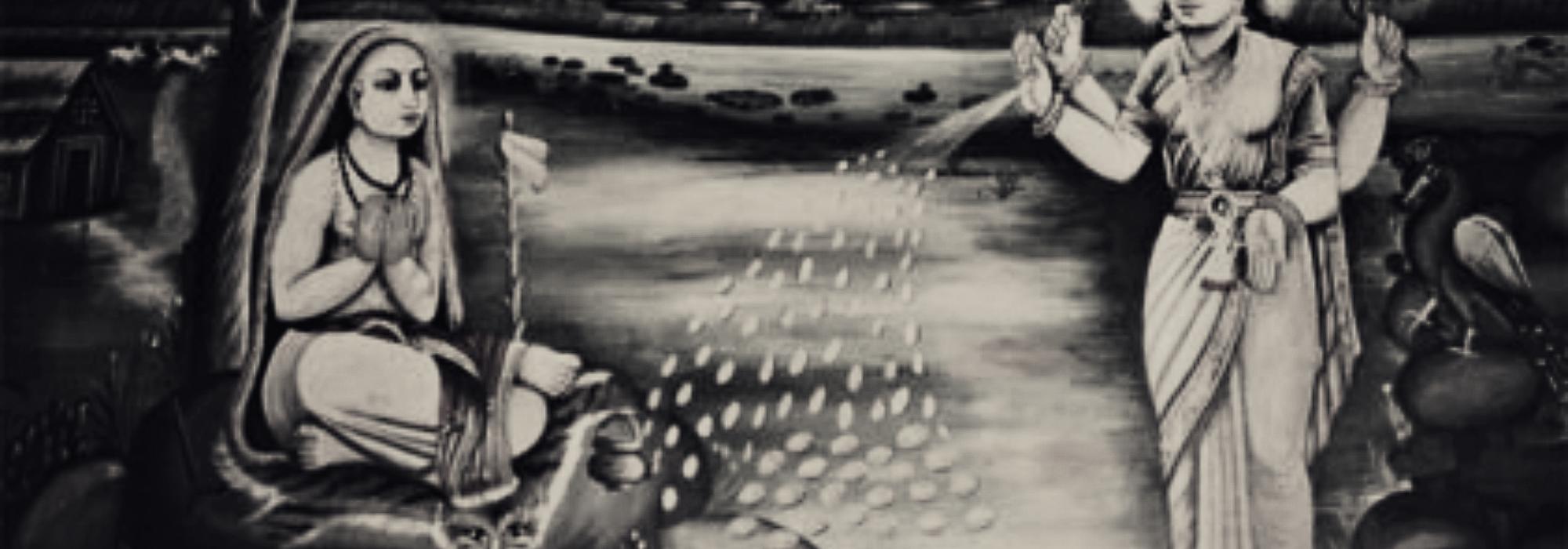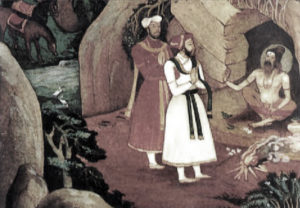Krishna points out in the Gita (3.21) – "यद्यदाचरति श्रेष्ठः तत्तदेवेतरो जनः" – that people follow the actions of a learned person. Vidyaranya was definitely one such shreshtha whose life is worthy of emulation though impossible for most people. His life has several gems worthy of adoration and emulation.
Born in a family with three other siblings (Sayana, Bhoganatha, and Singala), there must have been abundant opportunity to appreciate the joys of a joint family. “Charity begins at home” is a popular adage and it was definitely true in the case of Madhava-Vidyaranya. Brought up in such a cultured family, Madhava was steeped in sanatana dharma from a young age. The following few verses from Sayana's Alankara Sudhanidhi (a hitherto unpublished work) give an idea of the upbringing that Madhava and his siblings might have had.
मातर्मानय पादपद्मरजसा मौली ममाश्लिष्यताम्
तात त्वं च समेधयालकगतां प्रीतिं नखज्योत्स्नया |
अंब त्वं कपिले गृहाण यवसग्रासान्ममार्घ्यानुगान्
इत्याराधयतीश्वरं गुरुजनं गां चान्वहं सायणः ||O Mother! May my head be embraced by the dust of your feet!
O Father! May my curls be lovingly illuminated by the moonlight of your toe-nails!
O Kapile, the cow-mother! Please accept this offering of barley corn consecrated with ghi
Thus does Sayana worship daily the Supreme, his elders, and mother-like cow
That the family members had a well-rounded education becomes clear from the following verse.
वत्स व्यङ्जय कंपण व्यसनिनस्-सङ्गीत-शास्त्रे तव
प्रौढिं मायण गद्य-पद्य-रचना-पाण्डित्यम्-उन्मुद्रय |
शिक्षां दर्शय शिङ्गण क्रम-जटा-चर्चासु वेदेष्विति
स्वान्-पुत्रान्-उपलालयन् गृहगतस्-सम्मोदते सायणः ||Dear one, Kampana, the one addicted to music! Exhibit your excellence in music!
Mayana, display your dexterity in the composition of prose and verse!
O Singana, show your knowledge of the Veda through the krama and jatha ways of recitation!
Thus does the householder Sayana enjoy encouraging his children
This verse, though about Sayana, shows the family values and virtues of his family. Obviously, Sayana (and by induction, Madhava) would have imbibed the same values. Also, this family was not limited to scholarship and culture. The following verse shows his all-round conduct – including his prowess in warfare.
येन निर्मीयते नित्यं धनैर्-आयोधनैर्-अपि |
श्रेयसे यशसे दानं विदुषां विद्विषामपि ||Sayana, for well-being and fame, donates
money to scholars and battle to enemies!
Again, Sayana and by extension, Madhava would have had identical exposure to these samskaras leading to a harmonious amalgam of braahma and kshaatra values.
Though this family was culturally well-endowed, it is said that they were poor in a monetary sense. This should not be considered an anomaly, given that श्रेयस् (spiritual well-being) has been regarded higher than प्रेयस् (mundane pleasures) in sanatana dharma. Moreover, in the Bodhayana Sutra itself, to which this family belonged, brahmanas are exhorted to live on as minimum as possible. It is conceivable that this family lived this model life of limited means. However, in the later part of his life, Madhava-Vidyaranya, appointed to the post of prime minister of a large kingdom, did accept with equanimity the pomp and accompaniments accorded to such a position.
The sentence from the Gita, 'लिप्यते न स पापेन पद्मपत्रमिवाम्भसा' (5.10) – “Just as water doesn’t stick to a lotus leaf” – amply illustrates Madhava-Vidyaranya’s frame of mind.
Madhava and Sayana adorned the positions of royal guru and prime minister for the Sangama rulers – Harihara, Bukka, Kampana, Sangama II, and their successors. It is also well-known through historical sources that Madhava's father Mayana was chief purohita and royal guru of the elder Sangama. It can be safely assumed that there was a lot of goodwill and understanding between the Sangama and Mayana families across generations.
The brother-duo mastered several fields of knowledge by the grace of several gurus and the dint of their own efforts, further enriching them on the strength of their own experience. The two of them vastly exceeded any conceivable standard for multi-faceted scholarship. They find few equals (in terms of the scholarship seen in available works) in the Indian knowledge tradition. A bird’s eye view of the topics covered in their works is sufficient to make this conclusion.
The four Vedas and their branches, the six Vedangas – शिक्षा (the science of pronunciation, diction, and accent), व्याकरण (grammar), निरुक्त (semantic etymology), ज्यौतिष (astronomy and astrology), छन्दस् (meter and prosody), and कल्प (rituals and ceremonies) are well-covered in their unsurpassed veda-bhashya (commentary on the Vedas). Their mastery of the six classical and three unorthodox schools of Indian philosophy (दर्शन), the various schools of vedanta, the various agamas, the entire corpus of dharmashastras, the eighteen Puranas, the Itihasas, the Arthashastra, the Kamasutra, Ayurveda, and Classical music becomes evident even with a cursory study of their writings. Disciplines as varied as esoteric yogic practices to metallurgy, agriculture, and animal husbandry to aesthetics, sculpture, culture, and protocol have been covered in their works. Achieving a fair level of proficiency, let alone mastery, in any one of these fields can be a daunting task. We can thus only wonder about how the two brothers achieved this encyclopedic mastery. That these great souls offered all their learning into the altar-fire of societal progress makes them personifications of the glorious sanatana dharma values of charity and altruism.
भवन्ति नम्रास्तरवः फलोद्गमैः
नवांबुभिर्भूरिविलंबिनो घनाः |
अनुद्धताः सत्पुरुषाः समृद्धिभिः
स्वभाव एवैष परोपकारिणाम् ||
– नीतिशतकम् (भर्तृहरि)Trees bend down humbly with the growth of fruits.
So do the clouds with the gathered new waters.
Good people become meek with acquisition of wealth.
This is the nature of those benevolent to others.
(Bhartrhari's Nitishataka)
The above verse aptly illustrates the benevolence of the brothers.
After brahmacharya, it is clear that Madhava became a householder. The evidence for this comes from inscriptions that proclaim Madhavacharya to be a 'प्रति-वसन्त-सोमयाजि' (one who performs the shrauta soma yajna every spring), 'त्रिकाण्ड-मण्डन' (the decoration of the three branches of the Veda – emphasizing the कर्म काण्ड aspect) and 'अनन्त-भोगासक्त' (the enjoyer of unlimited pleasures). Note that these epithets do not befit either a sanyasi or a brahmachari. We must therefore assume that Madhava led a married life, as did Sayana and Bhoganatha.
A word about गृहस्थाश्रम (the householder phase) would not be out of place here for those who might consider it inferior to संन्यास (the renunciation phase). This second आश्रम (phase) of the four has been celebrated as the life support of the other three ashramas in works such as the Manusmrti. In the Raghuvamsha, Kalidasa hails the householder phase as 'सर्वोपकार-क्षम' (capable of performing all works of benefit). There is abundant opportunity in this ashrama for one’s mental and spiritual refinement as well as to help others.
It is apt, therefore, that Madhava-Vidyaranya spent most of his life as a householder. It can be surmised from several sources that he was a householder from the age of approximately 25 till the mature age of 80. It was this period that saw the secular and cultural achievements of Madhava and Sayana.
Not much is known about his wife, though. We also do not know how many children he had. However, we know that Someshvara Bhatta, the author of Nyayasudha (a treatise on the Tantravarttika of Kumarila Bhatta), was the son of Madhava-Vidyaranya.
It is likely that he had seen important centers of the country such as Varanasi, Ujjain, Prayag, Kanchi, Srirangam, Rameshwaram, Gokarna, and Srishailam. This helped his keen intellect in appreciating the political and cultural goings-on in the country, which made it possible for him to perform those momentous deeds.
In his event filled life he was not only Prime Minister of the Vijayanagara empire but also its royal guru. He led several scholarly groups and taught several students himself. He also guided efforts in several fields encompassing dharma, scriptures, art, and culture. His activity filled initial part of life of seventy years was followed by a ten to twelve year period of asceticism wherein he adorned the throne of transcendental wisdom – the leadership of the Sringeri matha.
His taking up of sanyasa and subsequent nomination to the leadership of Sringeri by Sri Bharati Tirtha happened around 1376 CE. It is likely that Vidyaranya composed his vedantic works during this period. Even so, it does not appear that he stayed in Sringeri during this period. Sayana had succeeded him to the post of Prime Minister. To guide Sayana in the stupendous task of composing the veda-bhashya as well as establish the rule of the expanding Vijayanagara empire, it is probable that Vidyaranya stayed on in Hampi, the capital. As he himself says in the Panchadashi:
ज्ञानिना चरितुं शक्यं सम्यग्राज्यादिलौकिकम्
It is indeed possible for the enlightened one to navigate politics and worldly affairs well
Vidyaranya, donning saffron, the mark of the sanyasi, worked tirelessly for the welfare of the world, epitomizing the virtue of निर्लेप-कर्म (non-attached duty) while being a जीवन्मुक्त (liberated while being alive). After witnessing the death of all the five Sangama brothers, Vidyaranya guided Harihara II to the throne of Vijayanagara and attained bodyless liberation around 1386 CE. (क्षय-नाम-संवत्सर ज्येष्ठ-बहुल-त्रयोदशी). The evidence from the inscription found in Vidyaranyapura clinches the issue of this date according to researchers. Sayana died in 1387 CE.
Thus ended the advent of a great avatara of an era.
To be continued...












































